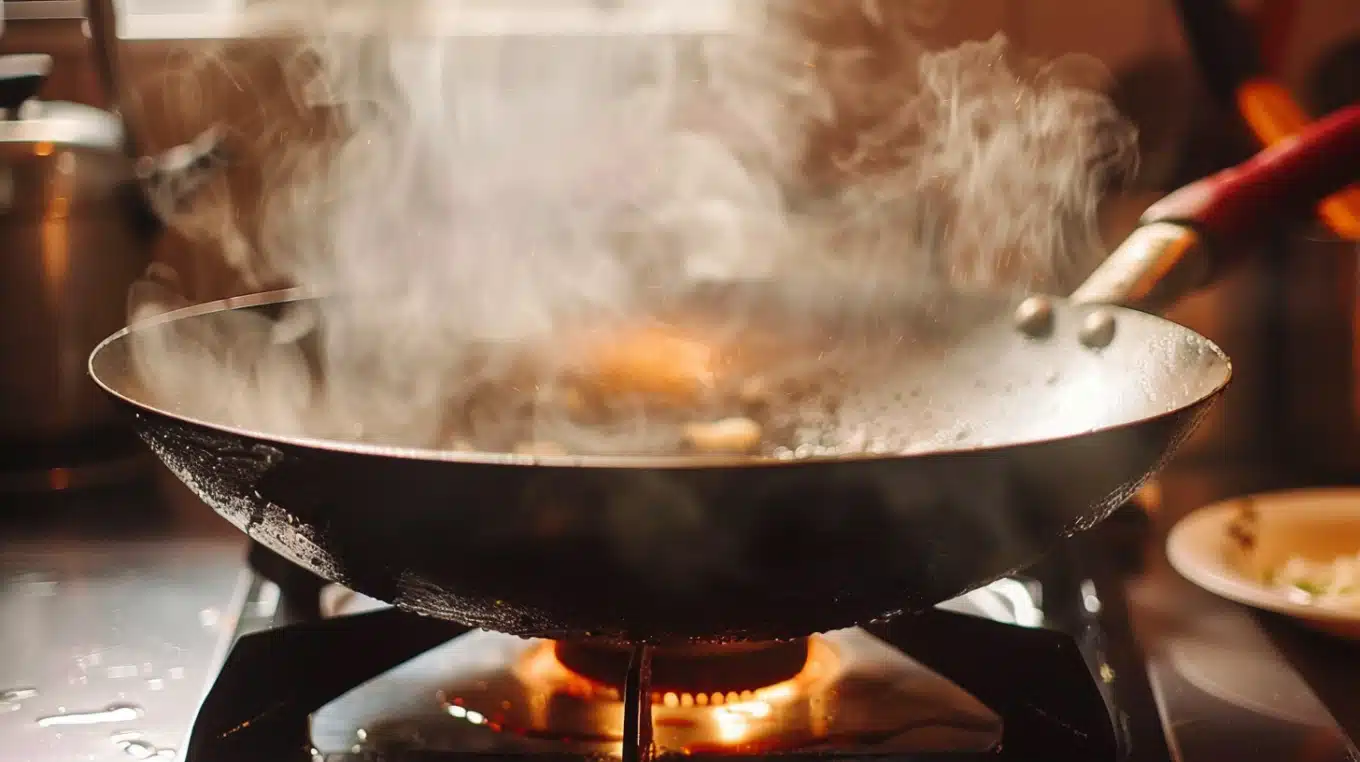Cooking with a wok can add incredible flavor to your meals, but it’s not as simple as just buying one and starting to cook.
To get the best results, you need to season your wok properly. Without seasoning, food will stick, and you won’t get that authentic taste you’re after.
By following the right steps, you can easily season your carbon steel wok and create a naturally non-stick surface that will make cooking a breeze.
A well-seasoned wok will also add depth and complexity to your dishes.
In this post, we’ll walk you through the process of seasoning your wok, from choosing the right oil to maintaining the perfect patina.
Get ready to become a wok seasoning pro and take your cooking to the next level!
What is a Wok?
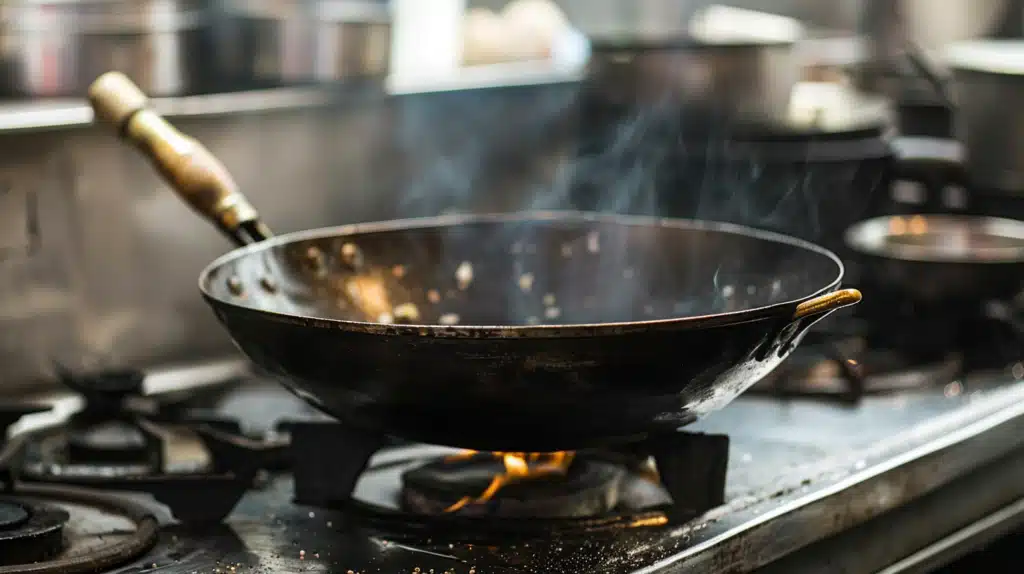
A wok is a versatile, round-bottomed cooking vessel typically made from carbon steel or cast iron. It has been a staple in Chinese cuisine for centuries.
Its unique shape and design allow for quick, high-heat cooking methods such as stir-frying, steaming, and deep-frying, making it an essential tool in many Asian kitchens.
The wok’s origins can be traced back to ancient China, which has played a significant role in traditional cooking techniques.
Its design has evolved to accommodate various cooking styles and has since spread worldwide, gaining popularity in Western kitchens.
Comparison of Cooking Vessels
| Feature | Wok | Frying Pan | Saucepan |
|---|---|---|---|
| Shape | Deep, rounded sides | Shallow, flat bottom | Deep, straight sides |
| Heat Distribution | High heat at the bottom, | Even heat distribution | Even heat distribution |
| lower on the sides | across the bottom | throughout | |
| Cooking Speed | Fast, due to high heat | Moderate | Slow |
| Versatility | Stir-frying, steaming, | Best for frying and | Best for liquids, |
| deep-frying, etc. | sautéing | slow cooking | |
| Nutrient Retention | Excellent, cooks quickly | Good, moderate speed | Moderate, slow-cooking |
| preserving nutrients | preserves some nutrients | can reduce nutrients | |
| Unique Feature | Wok Hei | N/A | N/A |
Tools Required for Seasoning a Wok

You’ll need the right materials and tools to season your wok successfully. So, having these essentials on hand will make the process smoother and help you achieve the best results for your work’s performance and durability.
1. Essential Tools
- Wok: A carbon steel or cast iron wok is ideal for seasoning. These materials can withstand high temperatures and develop a natural non-stick surface over time.
- Stove: You’ll need a heat source that can reach high temperatures, such as a gas, electric, or induction stove.
- Oil: Choose a high smoke point oil like peanut, canola, or grapeseed oil. These oils can handle the high heat required for seasoning without breaking down or becoming bitter.
- Paper Towels: Use these to spread the oil evenly across the wok’s surface. They can hold the oil without falling apart under high heat.
- Scrubbing Sponge: A non-metallic, abrasive scrubbing sponge is perfect for initially cleaning the wok without causing damage.
2. Optional But Helpful Items
- Wok Ring: This tool helps stabilize round-bottom woks on modern flat stovetops, making the seasoning process easier.
- Alternative High Smoke Point Oils: If you have allergies or dietary preferences, consider other options like avocado or sunflower oil.
- Heat-Resistant Gloves: Protect your hands from the high temperatures during seasoning with a pair of these gloves.
When selecting your materials and tools, opt for durable, high-quality options. With these materials and tools ready, you’ll be well-prepared to begin your wok seasoning journey.
Initial Seasoning Process
Seasoning your wok is a crucial step in preparing it for cooking. This process not only protects the wok from rust but also creates a natural, non-stick surface that enhances the flavor of your dishes.
By following these steps, you’ll ensure your work is ready to perform at its best.
1. Step-by-Step Guide to Seasoning a Wok
Cleaning to Remove Factory Oils
- Before seasoning, remove any factory oils or coatings that may taint the flavor of your food.
- Thoroughly wash your wok with hot, soapy water and a scrubber.
- Be sure to dry the wok completely to prevent rusting.
Heating the Wok to Open the Pores of the Metal
- Place your clean, dry wok on the stove over medium-high heat.
- As the metal expands, the pores will open, allowing the oil to bond with the surface during seasoning.
- For gas stoves, heat the wok for about 10 minutes, moving it around to ensure even heat distribution.
- On electric stoves, heat the wok for 5-7 minutes. Use caution to avoid burns.
Oil Application and Building the First Patina Layer
- Choose an oil with a high smoke point, such as peanut, canola, or grapeseed oil.
- Pour a small amount of oil into the heated wok, then use tongs to hold paper towels and rub the oil over the entire surface, including the sides.
- Continue heating the wok until the oil begins to smoke and the surface turns a dark, rusty.
- This indicates the formation of the initial patina layer.
2. Useful Tips
- Ensure the oil is evenly distributed across the wok’s surface to prevent uneven seasoning.
- If excessive smoke occurs, reduce the heat slightly and continue the process.
- Should the seasoning burn off in patches, repeat the process, focusing on the affected areas.
3. Maintenance After Initial Seasoning
- After seasoning, allow the wok to cool completely before storing it in a dry place.
- To enhance the seasoning, cook fatty foods or dishes that don’t require acidic ingredients for the first few uses.
By following this initial seasoning process, you’ll create a strong foundation for your wok’s performance.
Techniques for Seasoning a Wok
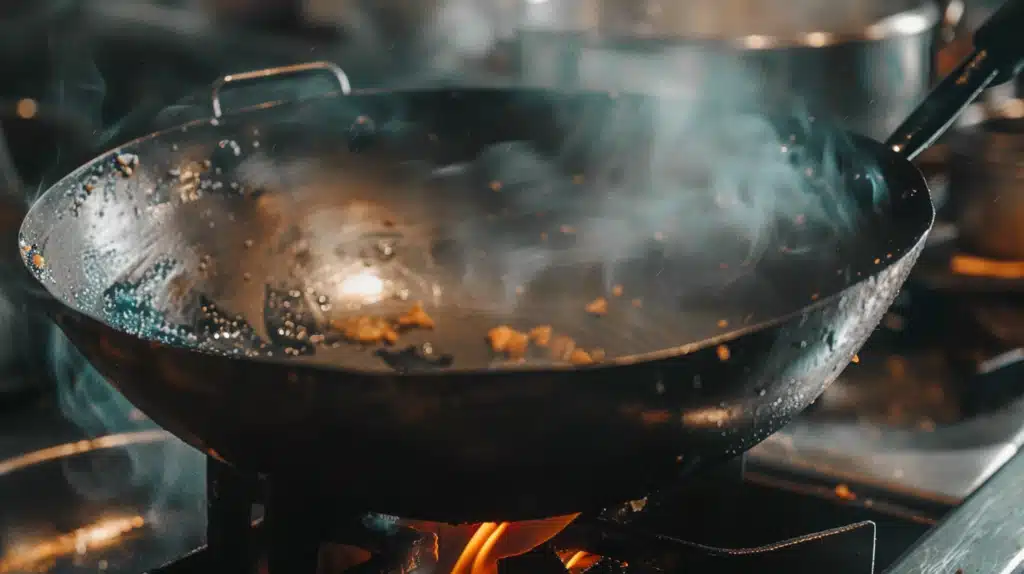
When it comes to seasoning your wok, there are several techniques to choose from, each with its own benefits and processes.
Let’s explore these techniques in detail.
1. Stovetop Seasoning Method
- To remove factory oils or debris, begin by thoroughly cleaning your wok with hot, soapy water and a non-abrasive scrubber.
- Place the clean, dry wok on your stovetop over medium-high heat.
- Pour about 1 tablespoon of a high-smoke-point oil, like peanut, canola, or grapeseed oil, into the wok. Then, use tongs and a paper towel to coat the entire surface and sides with the oil evenly.
- Continue heating the wok and rotating it to ensure even heat and oil distribution until the oil begins to smoke and the wok surface turns a dark, rusty color.
- This indicates proper seasoning.
2. Oven Seasoning Method
- Preheat your oven to 450°F (230°C).
- Clean your wok as described in the stovetop method.
- Using paper towels and tongs, apply a thin layer of high smoke point oil to the entire surface of the wok.
- Place the oiled wok upside down on the middle rack of the preheated oven.
- Bake the wok for 30-60 minutes, then turn off the oven and allow the wok to cool inside.
- This method is ideal for those who prefer a hands-off approach or have a wok with oven-safe handles.
3. Salt Seasoning Method
- Clean your wok as described in the stovetop method.
- Add a cup of kosher salt to the wok and place it on the stovetop over medium-high heat.
- Stir the salt constantly, pushing it up the sides of the wok for about 20 minutes.
- Remove the wok from heat, carefully dispose of the hot salt, and allow the wok to cool.
- Rinse the wok with hot water and dry it thoroughly.
- This method is perfect for deep cleaning or re-seasoning an old wok. The salt helps strip away rust or debris while building a new patina.
Regardless of the seasoning technique, always handle your wok carefully, especially when hot. After seasoning, allow the wok to cool completely before storing it in a dry place.
To enhance the patina, cook fatty or non-acidic dishes in your newly seasoned wok for the first few uses. By understanding these different seasoning techniques, you can choose the method that best suits your needs and equipment.
Why Season a Wok?
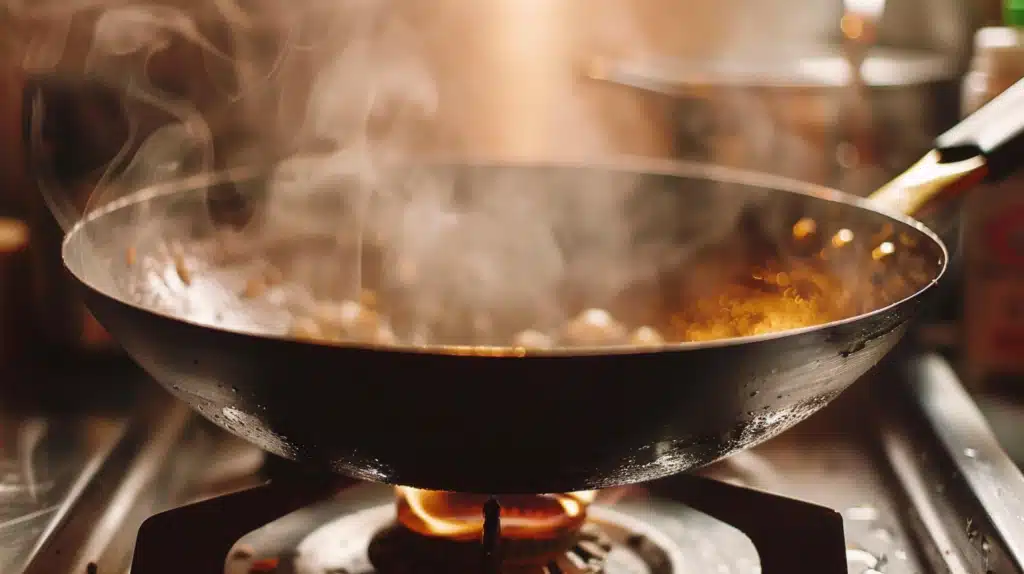
Seasoning a wok is a crucial step in preparing this versatile cooking tool.
It involves creating a protective layer on the wok’s surface that offers numerous benefits, making it an essential process for anyone who wants to cook with a wok.
1. Non-Stick Surface
- Seasoning a wok creates a naturally non-stick surface, which prevents food from sticking and makes cooking and cleaning much easier.
- A well-seasoned wok allows you to cook with less oil, resulting in healthier meals.
2. Rust Prevention
- Carbon steel and cast iron woks are prone to rust when exposed to moisture.
- Seasoning creates a barrier that protects the wok from oxidation and rust, extending its lifespan.
3. Enhanced Flavor
- As you continue to use and season your wok, it develops a patina – a layer of oil that has bonded to the metal.
- This patina not only improves the non-stick properties of the wok but also imparts a unique, subtle flavor to the dishes cooked in it, known as “Wok Hei” or the “breath of the wok.”
4. Improved Cooking Performance
- A seasoned wok has better heat distribution and retention, allowing for more efficient and even cooking.
- The non-stick surface also enables quick and easy tossing of ingredients, a crucial technique in stir-frying.
5. Longevity
- Proper seasoning and maintenance can significantly extend the life of your wok.
- A well-seasoned wok can last for generations, making it a worthwhile investment for any home cook or professional chef.
Caring for Your Wok
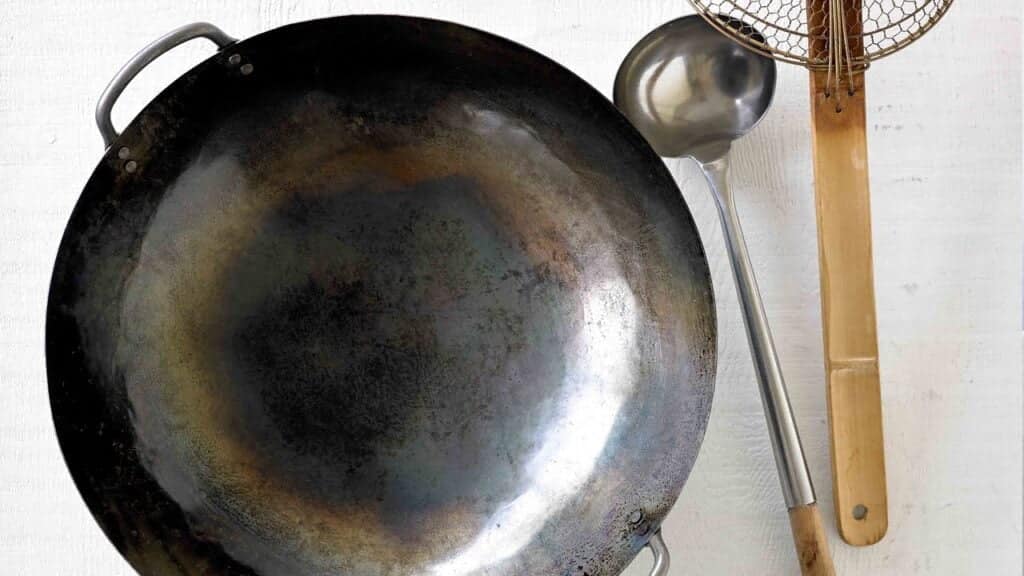
Regular maintenance is crucial to extend the life of your wok and preserve its exceptional cooking qualities.
Proper care not only enhances the non-stick properties of your wok but also contributes to the unique flavor profiles of the dishes you create.
Let’s explore some core maintenance practices and tips to keep your wok in top condition.
Core Maintenance Practices
1. Daily Maintenance Tips
- After each use, wipe your wok with a paper towel to remove any excess oil or food particles.
- Heat the wok briefly on the stovetop to evaporate any remaining moisture, which helps prevent rust.
- Cook with your wok regularly, as frequent use helps maintain and build the seasoning layer.
2. Cleaning the Wok Post-Use
- Clean your wok immediately after cooking to avoid damaging the seasoning.
- Use only hot water and a soft sponge or bamboo brush to scrub away any food residue gently.
- Avoid using dish soap, as it can strip away the seasoning layer. Only use soap when dealing with stubborn, sticky residue.
- Dry your wok thoroughly with a paper towel or over low heat on the stovetop to prevent rust.
3. Handling Rust and Re-Seasoning
- If you notice rust spots on your wok, it’s time to re-season it.
- Remove rust using salt, vinegar, or a cookware-specific rust remover.
- To re-season, follow the initial seasoning process: clean the wok, apply a thin layer of oil, and heat it until the oil smokes and the wok turns a dark color.
Advanced Tips and Techniques
- For deep cleaning, boil water with a tablespoon of baking soda in your wok to remove stubborn food residue.
- Periodically re-season your wok with a small amount of high smoke point oil to reinforce the protective patina, especially if you frequently cook acidic foods.
Common Problems and Solutions
- If you encounter sticky residue after cooking, soak the wok in hot water for a few minutes before scrubbing gently with a soft sponge.
- Discoloration or uneven seasoning is normal and will even out with regular use and re-seasoning.
- If rust appears unexpectedly, remove it promptly using the abovementioned methods and re-season your wok to prevent further damage.
Maintaining your wok is an ongoing process that requires attention and care.
By adopting a regular maintenance routine that fits your cooking style and frequency, you’ll ensure that your wok remains in optimal condition.
Conclusion
Mastering the art of wok seasoning is a crucial step in unlocking the full potential of this versatile cooking tool.
By choosing the right wok, using the best oils, and following the right seasoning steps, you can create a durable, non-stick surface. It will improve your cooking and enhance the flavors of your dishes.
Remember to care for your wok regularly, as this will ensure its longevity and performance for years to come.
As you embark on your journey to become a wok seasoning pro, embrace the process and enjoy the delicious results.
With a well-seasoned wok by your side, you’ll be able to create mouthwatering meals that will impress your family and friends.
So, fire up your stove, and let your newly seasoned wok be your guide to culinary excellence!
Frequently Asked Questions
How to Prepare a Wok for First-Time Use?
Wash the wok with soap and water, dry it, then heat it on the stove until it starts to smoke. Add oil and season the wok.
How Long Does It Take to Fully Season a Wok?
Initial seasoning takes about 15-20 minutes. However, the seasoning improves over time with regular use and proper care, which can take a few weeks or months.
What Should a Seasoned Wok Look Like?
A well-seasoned wok should have a dark, smooth, and somewhat glossy surface with a slight sheen. It should be free of rust and have a non-stick quality.
Do You Wash a Wok After Seasoning?
No, do not wash a wok with soap after seasoning. Instead, rinse it with hot water and use a soft sponge or brush to remove any food residue.
Is Seasoned Wok Unhealthy?
No, a properly seasoned wok is not unhealthy. The seasoning process creates a natural, non-stick surface, which allows for cooking with less oil, leading to healthier meals.

